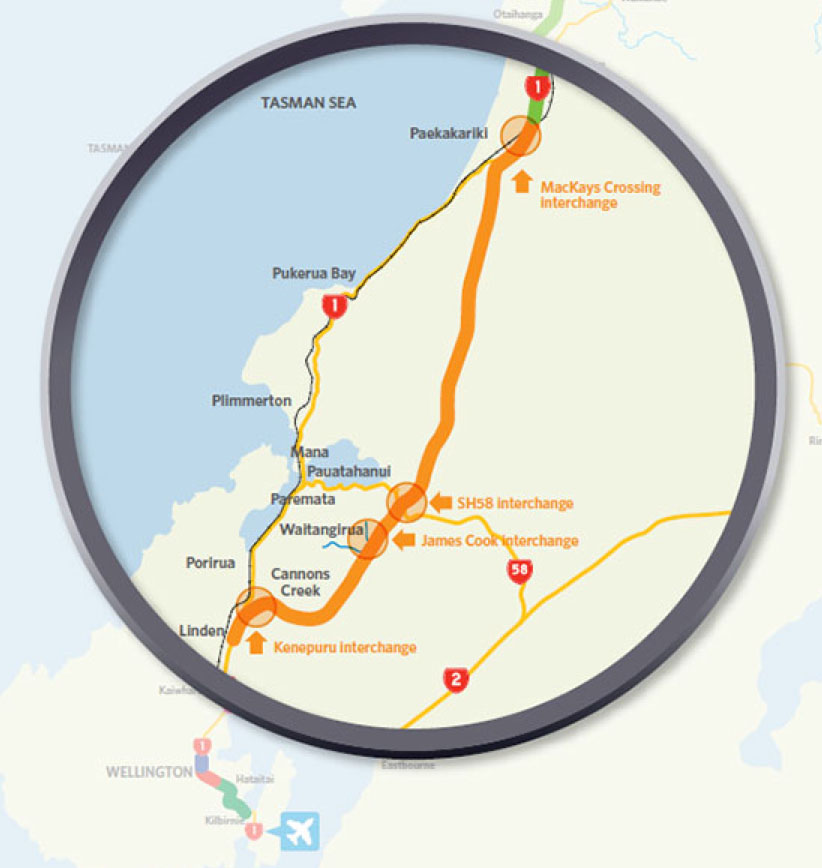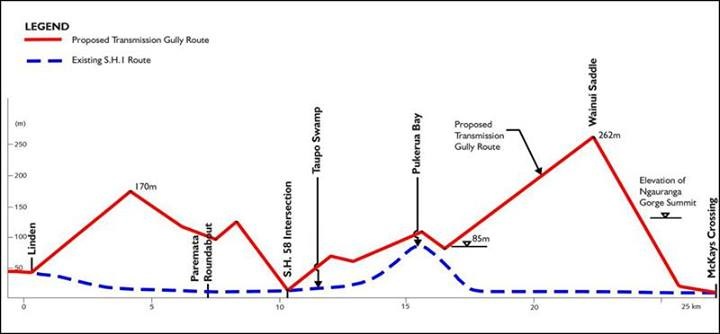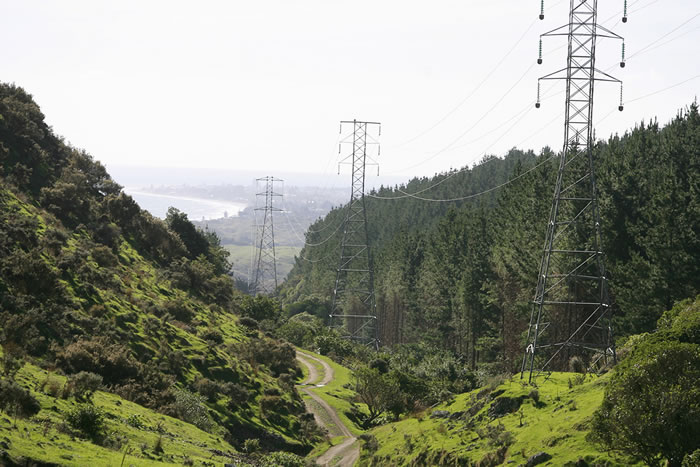It appears that I will have to eat my words, or eat my hat. A couple of years ago, when Transmission Gully was being talked about, I remember somewhere quite confidently stating that Transmission Gully would never go ahead, because it would never make economic sense for it to do so.

Seems that I am wrong – and right at the same time. It still makes no economic sense, but now that the KeyMaster has decreed it will happen, apparently it will.

We have written about it before – back in June 2008 at first, I believe, with THIS post, where we had this to say:
“…finished road will probably never see the light of day. Why? Well apart from the money, or lack of, there is the simple fact of it being steeper, and steep for longer (3 times longer) than the Ngauranga Gorge, so its never going to be that popular for trucks. They’ll always take the shortest, simplest route that they can. Coupled with that, it has to cross twisty earthquake faultlines, it has a route on shifty unstable soil, is 27km long through farmland, and more beside: but ultimately is doomed to failure through tolling. How so? Well, faced with a choice between a Toll Road, or a non-Toll Road, my hunch is that the average motorist will not be that keen to pay another $5 or $10 per day on top of the petrol bill, and enough will avoid it for it to make a huge loss. The other option would be for the ‘authorities’ to lump a toll on both the Gully and the Gorge – and guess how popular that would be!”

Then we followed it up with Boondoggle Gully posting in July 2008, which i think still holds our record for most comments received on a post – some good discussion of matters there. We noted then that:
“Just a few years ago, when costs were cheaper, it was Transit who was dragging the chain, and saying the prospect of T Gully was an unlikely event, if memory serves me right. Presumably hands were slapped, heads were rolled, and – well, hell, after all, Transit is a roading body – they suddenly found a new-found enthusiasm for the previous ‘uneconomic’ route. So what is the reason behind the change from half way up a hill to down in the valley, and if it is such a good economic move, why didn’t they do it from the start? Well I’m no roading engineer and so can’t say for certain (Transit roading engineers: feel free to blog in anonymously with your reply), but at a guess: halfway up the hill was thought to be a better place in terms of orthodox road building, rather than in the shifting shingle at the base of the gully. It is an earthquake faultline after all, and the ground conditions are not good (witness washouts on the Paekakariki hills nearby, with thousands of tonnes of gravel ending up in the bedrooms of a motel – twice), and there is a small trickle / raging torrent (depending on weather) in the bottom.”

One of our commenters, “Alex”, said that:
“I doubt that freight would use the gully, if the steepness of the road is as reported. The fuel costs and wear on the engine brakes etc would put truckers off let alone the option of a toll-free alternative if TMG is tolled. Just look at Route J in Tauranga as an example of truckies avoiding toll roads if there isn’t an obvious cost advantage in using it.
I supported TMG in the past when it was cheaper and do think there is merit in an alternative route in a disaster, plus I get the jollies from large construction projects. But it’s not worth $1b. I can’t see commuter traffic from the coast increasing. I already pay for the other road and the railway, and from my experience ever since the Mana bridge upgrade it serves its purpose. I dislike suburban sprawl, I wouldn’t want any of my rates encouraging it.”

And finally, a plea direct from me, right to the big fella right at the very top: Gerry Brownlee – please cancel Transmission Gully. I think my comments still stand there, really:
“There is a road proposal, with a cost to benefit ratio that flies out the window, for a road that goes up an earthquake fault line, is steeper for longer than Ngauranga Gorge, and is going to cost over a billion $$, which neither central nor local government has the money to finance. On a list of projects that need to be cancelled to pay for the rebuilding of Christchurch, I’d put this one right at the very top. Wouldn’t you?”






Worth noting that the $1.2 billion price tag is in 2008 dollars. Whilst inflation has been very low as of late, the price of diesel has soared quite a lot, and if there is one thing that large earth-moving machinery uses a lot of, it is diesel. By the time this project is finished in – what is it – 2020? expect the costs to have gone up significantly. Dare I say double?
I’ve just checked the Auckland based Transport blog’s posting on Transmission Gully from a couple of days ago – 83 comments! Way to go guys! And their commentary is so much better than I can do here to. It’s great to see so much good discussion going on – shame that it’s not here, but it’s worth checking them out.
http://transportblog.co.nz/2013/10/30/transmission-gully-to-start-next-year/
Oh, and Guy – apparently the cost of the “Northern Corridor” is already sitting at $2.5 billion, although that probably includes a bit more than just the Trans Fat gully.
I was in favour of this till I saw the gradient. It won’t work. The main reason for building TMG would have been to put trucks onto the highway, thereby freeing up the old state highway for those wanting a less congested route. Also crossing so many faults as it does, does not guarantee a safe secure highway in and out of the city in the event of the big one happening. Like so much of what this Govt is doing, it is driven by sheer ideology, not practical commonsense.
I’m not against TGM per se, but once again, no one’s done any investigation as to why the cost projections for TGM managed to double. Kickbacks to Big Trucking and Big Construction?
Watching the flythrough video of the Gully I have to wonder what mental capacity any backer of this project has. Even the mentally ill can see this is a bad idea.
Ha! Sav – at first I was going to say that your comment was a bit harsh, but actually, it does show the pressure the government is in. The mental capacity of the Minister for Everything, Mr Stephen Joyce, must indeed be under quite a severe strain – not just from running several portfolios and ministries all at the same time, but also from the road trucking lobby group. The Mainfreights and LinFox of this world. Their answer is, of course, that the more, and bigger highways the country has, the greater the productivity we collectively have as a nation. Truck sizes are getting rapidly larger – just a few years ago the upper limit of truck tare loads was raised from 42 to 45 tonnes, then to 55 tonnes, and now I see that 60 tonnes – or was it 66 tonnes? are being phased in. The example being promoted on the radio after the announcement last week, from one company owner, was that hooray, they would be able to get rid of one truck, and that means sack one driver. Hardly sure if that really qualifies as an increase in productivity.
Presumably therefore, truckies must be looking forward to this new road, despite the fact it is steeper, for three times longer than the Ngauranga Gorge. Anything for them to avoid getting tangled up in Otaki.
From thevDomPost today:
“New Zealand Contractors Federation chief executive Jeremy Sole said it was “exciting” that the Gully project would be done as an “Availability PPP” whereby the road wasn’t paid for through tolls.
“That’ll never work in New Zealand because the patronage isn’t there.
“So they are basically getting paid on the amount of time the road is 100 per cent available.
“That will get factored into the design to make sure they can maximise their revenue.
“That will change the paradigm around building roads in New Zealand.”
Currently roads were built with a “flexible pavement” which meant more money would be spent on maintenance in the future, he said.
“But they [Transmission Gully road builder/operator] will be saying ‘how can I build this once and . . . maintain it as little as possible’.
So is this man saying that they will build this road out of concrete?, would make an interesting comparison with a comparable “flexible pavement” i.e compressed base and asphalt,
will be interesting to see which of the two short listed consortia are chosen
Wellington Gateway Partnership:
Leightons Contractors Pty Ltd (lead)
HEB Construction Ltd
InfraRed Infrastructure General Partner Ltd
The Bank of Tokyo-Mitsubishi UFJ, Ltd (BTMU)
The Accident Compensation Corporation (ACC)
Positive Connection:
John Laing Investments Ltd (lead)
Fulton Hogan Ltd
The Fletcher Construction Company Ltd
Macquarie Group Holdings New Zealand Ltd
Woodward Infrastructure Ltd as General Partner of Public Infrastructure Partners LP (PIP Fund)
What a scam. The whole idea that people should be living 50kms away and commuting to Wellington, oh and that the rest of the region, nay country, must pay to support those people’s lifestyle has long peeved me off. It’s why I don’t really want Kapiti coast to be part of any unified Wellington city. That said, Porirua and the Hutts have their dirty paws all over this project too.
I suspect part of the hidden rationale for this project is to open up land around Judgeford/Belmont Regional Park for suburban development. Fine by me, Wellington has many pluses but one huge minus is low population/lack of population growth, especially compared to Auckland and Christchurch.
Except that you can’t get off the Highway. No stopping !
If there’s a suburb there then a cloverleaf interchange would be no problem to add on so there will be stopping if the demand is there IMO
I disagree with this whole RONS idea – if it doesn’t make the cost/benefit ratio then it should be out on it’s arse.
I can see the rationale behind a decent roading system when it will be self-driving electric cars in the close future but in this case traffic will swell to fit available routes.
As Erentz says, we are subsidising people living up the coast and we could have double laned the existing road with a clip-on and easily spent less money for more benefit.
The peat swamp North of Mackays is still there, bumping up and down like a Treasury forecast in the wind.
The Otaki River bridge is still a bottleneck.
On the positive side some work has been done at the intersection by Southwards and they’ve lowered our (high by international standards) BAC limit – I can drink a bottle of red and be under the limit which is a farkin joke.
I know that the area lends itself to throttled transport solutions because of its geography but I would have thought that an alternative road from Jville to the Hutt for when SH2 is gummed up would be a better idea, or making the Esplanade an expressway for through traffic to Wainui and Eastbourne.
The Aucklanders are right – this thing smells like a boondoggle
One of the most annoying things about this is how easy it would be to four lane the existing highway (at about half the cost). While you would still have to grind along the Mana esplanade, beyond that there was land set aside for a pukerua bay bypass (now sold), it would have been child’s play to widen the existing coast road into the sea; and a Paekakariki interchange could surely be engineered. Boom, just saved $500 million bucks we don’t have to borrow.